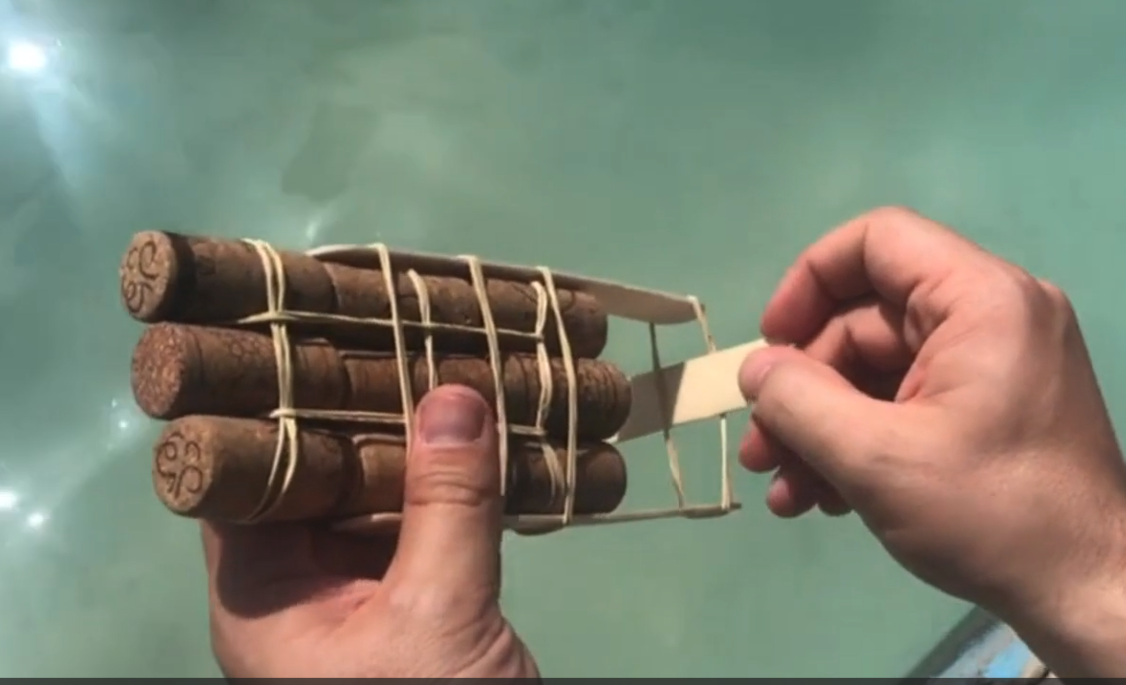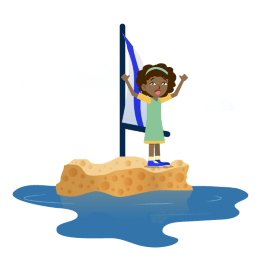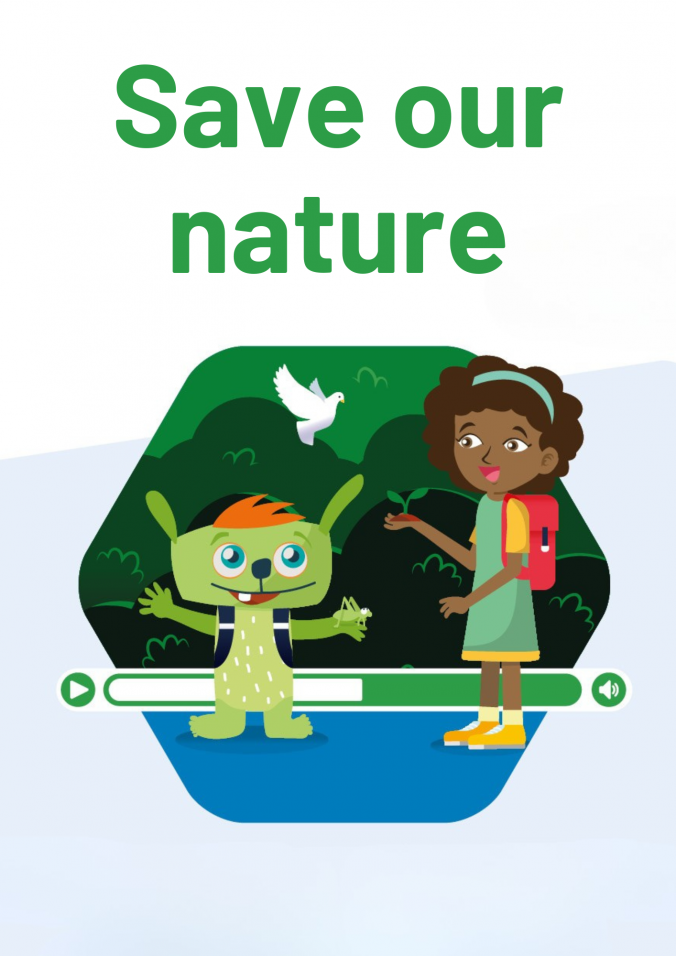How does a Propeller Boat Work?

Overview
Overview
Keywords: sun energy, food (chemical) energy, motion energy, tension energy, rotational energy, energy transformations, propeller boat
Subjects: science, physics
Age group: 7-9 years old
Difficulty level: ● ● ○ (medium)
![]()
![]()
This experiment is part of the unit "Eco-Motion" written by: Semih Esendemir (TR), Rute Oliveira (PT)
This experiment is about the journey of Lilu and Alina, who cannot return home by sailboat, and want to return home by propeller boat. Throughout the experiment, the focus is on the design of a propeller boat, the movement of a propeller boat and energy transformations.
The video focuses on how the energy needed to rotate the propeller is obtained. Students are expected to explore the energy transformations in the creation of muscle power. The video offers students the opportunity to reflect on the materials used in the design of boats that move without the use of fossil fuels in everyday life and the energy sources that enable these boats to move. The video aims to develop students' communication, collaboration, analytical thinking, critical thinking, problem solving, creativity and innovation skills.
The experiment
Required materials
- 9 corks
- rubber bands
- a flat wooden stick (e. g. ice cream stick)
- 2 pencils
- a large container filled with water
Experiment guide
- Divide the nine corks into three groups of three.
- Combine each three corks with a rubber band.
- Create the floor of your boat by combining the three groups of corks with rubber bands.
- Attach a pencil to each side of your boat with rubber bands.
- Put a rubber band between the two ends of the pencils.
- Cut a small propeller from a flat wooden stick.
- Thread the propeller you created from the wooden stick between the rubber and rotate it (see picture).
- Put your propeller boat in the water and release the propeller.
- Observe the movement of your propeller boat.

Questions for students
Here are some suggestions for questions that you could ask the students when the video stops.
- How can the boat be moved using muscle power?
- What is the source of the energy in our muscles?
- Does the direction of the propeller and the number of rotations affect the motion of the boat?
The experiment with the result
Explanatory video
Lilu and Alina could not return home with the sailboat they designed because the wind was not blowing constantly. Inspired by the propeller on their motorboat, they designed a boat with a propeller. They think they can return home by moving the propeller with their muscle power. What do you think about Lilu and Alina's new idea? Can Lilu and Alina reach their home this way? The answer to these questions lies in understanding the structure of elastic materials and the energy we use in our muscles.
We use our muscles for many things in our daily lives: walking, writing, carrying things, etc. Our muscles need energy to perform all these activities. We obtain this energy from food. We call this energy stored in the structure of food chemical energy. In the contraction of muscles, the chemical energy stored in nutrients turns into motion energy. The source of this energy stored in food is the sun's radiant energy.
The sun not only lights and heats the earth, it is also the source of the energy that plants need. Plants convert the sun's radiant energy into chemical energy by using water from the soil and carbon dioxide from the air. This process is called photosynthesis. Radiant energy converted into chemical energy through photosynthesis is transferred to other living things through nutrition. We obtain the energy in our muscles indirectly from the sun, and we can make the boat move by making the propeller turn.
Here you can download the transcript of the video as docx and pdf.
After watching the video, you can have your students to the interactive exercise "How does a propeller boat move?"
In this video, students are expected to design a propeller boat powered by muscle power (energy) for Lilu and Alina who cannot return home from the island by sailboat. The aim of the video is to construct and environmentally friendly vehicle that will show the conversion of radiant energy into chemical energy and the conversion of energy in food into movement energy with our muscles.
Cork, rubber and wooden sticks for the propeller were used in the boat design. Cork is obtained from the bark of the cork oak tree. Cork has a porous structure. Since its pores are filled with air, it can float on the water surface.
The rubber band that will allow the propeller to rotate is a flexible material. Flexible objects such as springs and rubber band have energy storage properties. The energy that is stored in flexible objects when they are compressed or stretched, is called the potential energy of elasticity. To stretch a rubber band, we need muscle power, i.e. chemical energy.
Our muscles need energy to work. This energy need is met from food. We call this energy transformed from the sun’s radiant energy through photosynthesis and stored in the structure of food chemical energy. In the contraction of muscles, the chemical energy stored in food turns into kinetic energy. The elastic potential energy of flexibility that we store in the rubber band through the kinetic energy of our muscles’ movement allows the propeller to rotate and the boat to move. The energy of the rotating propeller is called rotational kinetic energy.
You can download or copy the h5p file below by clicking on the "reuse" icon in the bottom left corner.
Solution for teachers
The correct order is:
1. radiant energy (from the sun)
2. chemical energy (from food)
3. rotational kinetic energy
4. elastic potential energy
5. rotational kinetic energy
6. motion (kinetic) energy
How does this video link to sustainability?
Since the main topic of the video is to design a boat that moves with muscle power without the use of fossil fuels, it draws attention to the issue of sustainable energy consumption. It gives students the opportunity to design different means of transportation that minimize the use of fossil fuels. For a sustainable future and to reduce climate change, it is very important to consider the sources from which we obtain energy.
Differentiated learning
Explore ideas how you can use this material in your class and adapt it to a group of various levels and learning styles.
Extension activity: Solar boat experiment
You can repeat this activity using direct solar energy and convert your propeller boat into a solar boat. You will get a boat that uses solar energy directly to move by connecting a solar panel and an electric motor to the boat with rubber bands.
For your solar boat you need a solar panel, an electric motor, a propeller and connecting cables.
Remove one cork from your cork boat and replace it with an electric motor and propeller. Connect the electric motor to the solar panel with the connecting cables to make your solar boat.
Safety note
Please check the regulations in your country when choosing the materials to be used in this activity. Although there is no risk involved in using solar panels and specific waterproof electric motors in this activity, it is recommended that you explain to your students that they should be careful with electricity and water and that they should tape the cables properly with electrical tape.
Easier
You can introduce the activity in different ways to involve various groups of students in your class. For example, you can tell the story of Lilu and Alina through reading, drawing or drama. This can help to reach the whole class. You can bring different flexible materials (sponge, plastic ruler, spiral spring etc.) into your classroom to introduce flexible materials to your students. Individual learning plans can be prepared for students who have difficulty in group work, while students who have difficulty in individual learning can work in groups. During the propeller boat design process, students can reflect their own ideas and thoughts, and support can be provided according to individual needs.
More challenging
In higher level student groups, energy chains can be discussed in more depth. Variables affecting the motion of a propeller boat (such as rubber of different thicknesses, propellers of different sizes, the direction and number of propeller rotations) can be investigated. In addition, students can take measurements, collect data and tabulate the data like a researcher. The table below can be used as an example. In this table, students can be asked to compare the number of turns of the propeller and the distance the propeller boat travels on the water. If you wish, these data can be graphed.
|
Measurements |
Number of times the propeller is turned |
Distance the propeller boat travelled on water |
|
Measurement 1 |
|
|
|
Measurement 2 |
|
|
|
Measurement 3 |
|
|
|
Measurement 4 |
|
|
Career orientation
Which career options are linked to this experiment and how can you introduce them to your students?
As this activity aims to demonstrate energy transformations through engineering and design processes, it can be linked to the following professions:
Marine and ship engineering, naval architecture
- To learn more about marine engineers, you can watch this career girls video.
Materials engineering
- To learn more about materials engineers, you can watch this career girls video.
Energy systems engineering
Outlook
At the end of the activity, each student is expected to design a boat with a propeller and move the boat by using the potential energy of flexibility. Giving students the opportunity to design their own propellers will contribute to the development of their imagination and creativity. It will be useful for students to experiment with variables such as the number of corks to be used in the boat design, the size and shape of the propeller, the type and thickness of the rubber used, etc. in order to discover the differences in the movement of the boat.
To enrich your activity, pictures introducing flexible materials (trampoline, wind-up car, etc.) can be shown at the beginning of the activity. If possible, students can enter the activity by playing with trampolines or wind-up cars.
If you want to adapt your activity for students at different levels, you can organize a competition to design the best propeller boat that moves through the water.
Students can use any type and thickness of rubber and design their own propeller. At this point, students can be left free to choose the materials they will use.
You can convert your propeller boat into a solar boat. To learn more about the construction, watch the solar boat video.
Propeller, Encyclopædia Britannica
(last accessed 04.12.2024)Kinetic energy, Encyclopædia Britannica
(last accessed 04.12.2024)Potential energy, Encyclopædia Britannica
(last accessed 04.12.2024)Energy Transformation: How Does It Do That?, National Geographic Education
(last accessed 04.12.2024)Career orientation videos:
Marine engineer, Career Girls
Materials engineer, Career Girls(last accessed 01.04.2025)
In Does Rubbish Float or Sink? students can discover what conditions are needed for an object to float.
This experiment is part of the unit "Eco-Motion" written by: Semih Esendemir (TR), Rute Oliveira (PT)
Share this page

